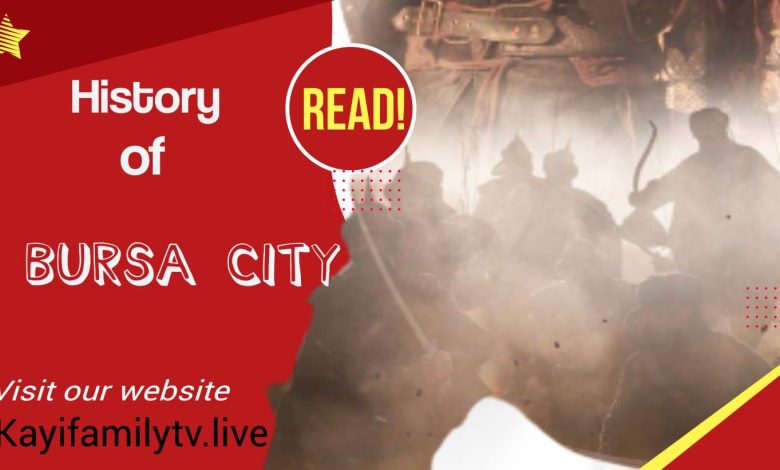History OF Bursa

The Real History of Bursa
★ Identity and Geographical Location of Bursa: Bursa Province (Turkish: Bursa ili) is a province of Turkey located on the coast of the Sea of Marmara in northwestern Anatolia. It is bordered by Balikesir to the west, Kutahya to the south, Bilesik and Sakarya to the east, Kozaili to the northeast and Yalova province to the north. The province has an area of 11,043 sq km and a population of 28,42,547 (2015). According to the 2000 census, the population of the province was 21,25,140. The population in 1990 was 16,03,137. Bursa Province consists of the following districts:—-
Buyukorhan, Gamelik, Gursu, Hermancik, Inegul, Iznik, Karajabe, Keles, Kestel, Mudania, Mustafa Kemal Pasha, Nilufer, Orhaneli, Orhangazi, Osmangazi, Yenisehir, Yildirim
Our Discussion Subject:
- 1/ Bursa Identity and Geographical Location
- 2/ Rise of Ottoman Empire
- 3/ Siege of Bursa
- 4/ Bursa First Capital of Ottoman Empire
- 5/ Osman Ghazi’s Last Campaign Bursa
★ Rise of the Ottoman Empire: On January 17, 1299, “Osman Gazi” declared his petty kingdom’s independence from the Rum Sultanate and assumed the title of Khan of the Qayi tribe. The Ottoman kingdom was one of the petty Turkish kingdoms in Anatolia after the collapse of the Seljuks. Among these states, the Ottomans eventually united Anatolia under Turkish rule. Due to the westward invasion of the Mongols, a large number of Muslims sought refuge in Osman’s kingdom. The fall of the Byzantine Empire led to the rise of the Ottoman Empire.
★ Bursa Blockade: The historical historian “Laonikos Chalkokondlais” noted that the Ottomans took advantage of the Byzantine Civil War of 1321-1328 to capture the city: “Andronikos decided that his grandfather was already old and so they began to fight each other over the throne. He was very obstinate and caused constant trouble. He brought the Serbs to fight and allied himself with the leading Greeks in the struggle for the throne. As a result, they were unable to prevent the Turks from entering Europe. “At this time Andronikos was starved and At the end of the siege, Osman Ghazi captured him and then began to capture other cities in Asia.
According to some sources, Osman Ghazi died a natural death just before the fall of the city of Bursa. While others believe that he lived long after the conquest of Bursa and was buried in Bursa after his death.
:— Paul K. Davies wrote, “The capture of Bursa established Osman I (Ottoman) and his successors as a major power in Asia Minor, marking the beginning of the Ottoman Empire.”
★ Bursa, the first capital of the Ottoman Empire: After the fall of the city, Osman Gazi’s son and successor, Orhan Gazi, declared it the first official capital of his empire, which remained in force until 1366, when it was moved to Edirne. As a result, the city of Bursa has earned a special place in Ottoman history as the founding city of the empire and also as the birthplace of Ottoman architecture due to mosques such as the Bursa Grand Mosque (1399), the first Bayezid Mosque (1395), the Hadevendigar Mosque (1385), the Yael Mosque (1421) etc. made a profit
Orhan Gazi encouraged the growth of urban living during his reign by building buildings such as palaces, Turkish baths, mosques, and kavansares. He also built a mosque and a madrasa in what is now Hisar district. After his death, he was buried next to his father’s tomb. The Muslim traveller Ibn Battuta, who visited Bursa in 1331, was impressed by the behaviour of the Sultan and described Bursa as an impressive city, with “neat markets and wide streets, all around which one sees gardens and flowing fountains”.
★ Osman Gazi’s last campaign Bursa: According to “Stanford Shore”, Osman’s first real military victory came after the collapse of Seljuk power. During this time he was able to capture the fortresses of Eskişehir and Karajahisar. He then conquered Inegül, the first important city in his region. He then captured Yenisehir, which became the capital of the Ottomans.
After defeating the Byzantines at the Battle of Bafius near Nicaea in 1302, Uthman positioned his forces near Byzantine-held territory. A large number of Ghazi warriors, Islamic scholars and dervishes began to settle in areas under Osman’s control. Many of the immigrants joined his army. The later Ottoman rulers referred to themselves as the “Sultans of the Ghazis”, being the meeting ground of Ghazi warriors and adventurers from various backgrounds.
As Uthman’s influence grew, the Byzantines gradually abandoned rural Anatolia. The Byzantine leadership tried to stop the Ottomans but they were not well organized and effective. As a result, Osman (through the Konur Alp and Angchakocha) extended his borders to the Sakaria River in the north and the Sea of Marmara in the south. In addition, his followers took part in the conquest of the Byzantine city of Ephesus near the Aegean Sea. As a result, he captured the last coastal Byzantine city. But this city came under Aydin’s emir.
Osman Ghazi made the last campaign of his life against Bursa. He did not personally participate in it. But he wanted to conquer this city for a long time. The conquest of Bursa was very important to the Ottomans as the city became a focal point for the neighbouring Byzantines. The city served as a base for later campaigns against the Byzantines. Later, Osman’s son Orhan Ghazi I defeated the siege of this city for six or nine years and moved the capital here. Read More




